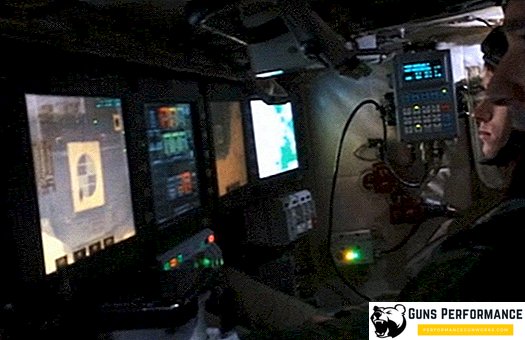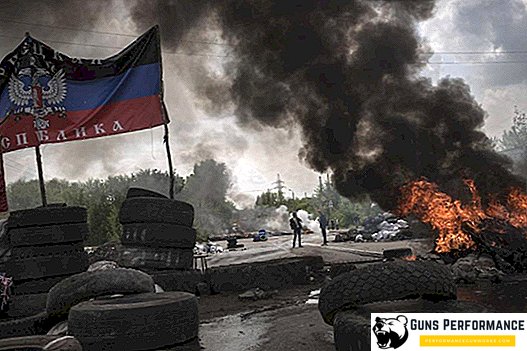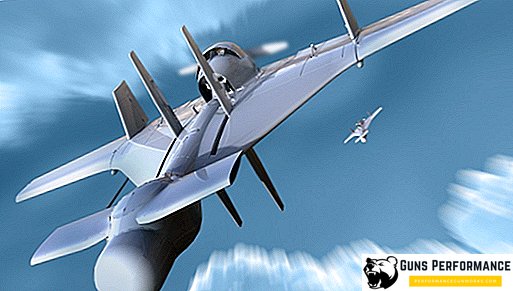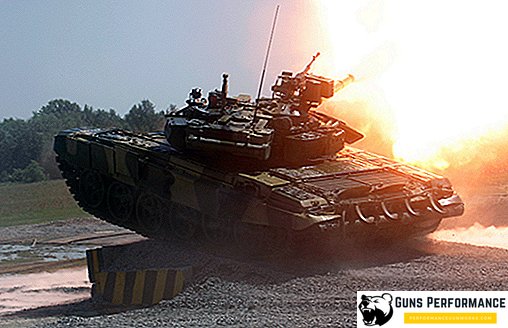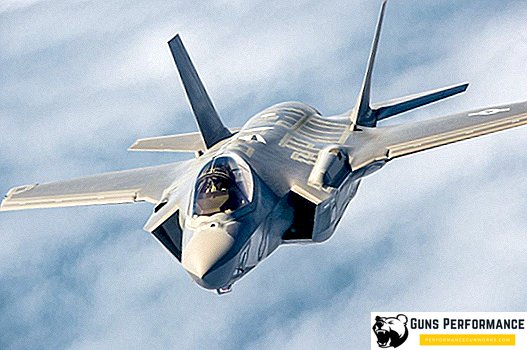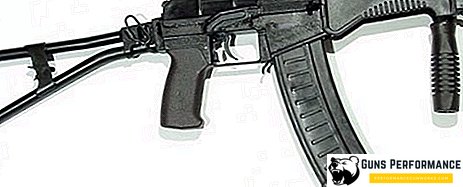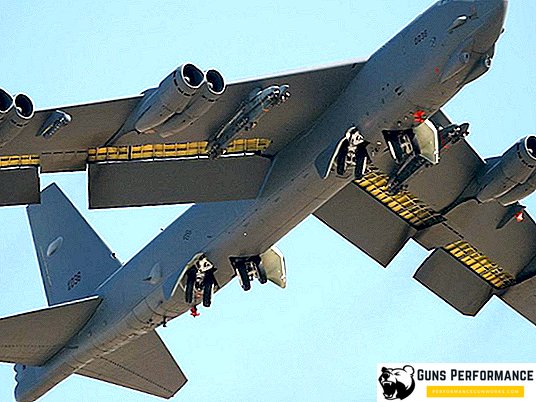
The Boeing B-52 Stratofortress is an American long-range strategic bomber, created by the Boeing Corporation during the Cold War era, capable of carrying nuclear weapons on board. This is one of the symbols of Pax Americana - the formidable nuclear giant of a superpower. The B-52 made its first flight back in 1952 and for more than sixty years this aircraft has been the basis of American strategic aviation.
According to the plans of the Pentagon’s strategists, the B-52 will remain in this capacity until at least 2030. It is planned to spend almost 12 billion dollars to upgrade these machines. Experts say that each such bomber can fly for 83 years, this period ends only in 2040.
The main task of Stratofortes was the delivery of two high-power thermonuclear bombs to any point of the Soviet Union.
During his service, the B-52 participated in almost all the conflicts in which the US Air Force was involved. This bomber is a champion among combat aircraft in range. During its operation, it has been repeatedly upgraded, created dozens of modifications of the aircraft.
A total of 744 B-52 units were produced, the cost of the latest modifications (for 1998) is $ 53.4 million.

History of creation
The design assignment for the new bomber was prepared in 1946, a few months before the start of the B-36 tests. The US military needed a new strategic bomber with a radius of 8050 km, capable of carrying 4.5 tons of bombs, with an average flight speed of 480 km / h. The company "Boeing" immediately joined the work on the creation of this aircraft and eventually won the competition, receiving funds for the continuation of the project.
The victory of "Boeing" was quite natural: this company for many decades closely cooperated with the US Air Force, the company produced the first combat aircraft back in 1917. Later, Boeing created fighter jets for the United States (MF-3, R-12, R-26), and then tightly engaged in the development of bomber aircraft.

In 1935, the company created the B-17 aircraft - the famous “Flying Fortress”, a bomber who took the most active part in most of the battles of the Second World War. It is curious that the initially heavy bombers were built to combat maritime targets, since the United States did not plan to intervene in conflicts beyond its borders.
In the mid-1930s, Boeing began work on the creation of a super-heavy bomber, which resulted in the emergence of the B-29 Superfastress, from which atomic bombs were dropped on Japanese cities. This car was so successful that its copy (it turned out to be unimportant) was produced in the USSR under the designation Tu-4.
Given the rich and successful experience of cooperation with the US Air Force, it is not surprising that the Boeing received the order to create a new bomber.
Atomic weapons, created at the end of World War II, completely changed the balance of power on the world chessboard. The decisive factor was not only the presence of nuclear weapons and their quantity, but also the ability to deliver them to the desired target. Rocket technology at that time was still in its infancy, so the two superpowers, the United States and the Soviet Union, threw all their forces on the creation of long-range strategic bombers.
Another important point was that during this period, piston aviation was already in the phase of its sunset. The future was for jet planes.
After the war, American aircraft designers gained access to captured German developments in the field of jet propulsion, and they were very advanced.
In the late 1940s, the Boeing B-47 Stratojet medium jet bomber was created by Boeing, which had a small sweep wing and six turbojet engines. This scheme was quite successful, so it was decided to use it for the future heavy bomber.

In 1948, the final design of the new aircraft was prepared with a maximum range of 4,930 km and a speed of 910 km / h. He was supposed to take on board 4.5 tons of bombs and have a take-off weight of 150 tons. They planned to install 6 TRDs on a bomber. The beginning of the Korean War significantly accelerated work on the future of the B-52.
The first prototype aircraft was built by the end of 1951, but it was being finalized for a long time, so test flights began only in October of the following year. The pre-production bomber batch was ready in August 1954; the US Air Force began operating new machines in February 1955.
On May 21, 1956, the first hydrogen bomb was dropped from the B-52, and in the same year several long non-stop flights were made. In 1957, three B-52s made a round-the-world trip, and in 1962 a flight range record was set on this aircraft: in 22 hours and 9 minutes, the bomber covered a distance of 20188 km.
During the Cold War years, part of the B-52 bombers carried round-the-clock duty at airfields, having nuclear weapons on board. In the mid-60s to reduce the probability of hitting the aircraft, they were dispersed at 36 airfields. At the same time, ten bombers were constantly on alert in the air, ready at any moment to strike at the enemy.
At the end of the 80s, about 40 Boeing B-52 Stratofortress were on combat duty, 71 aircraft were lost for many years of service due to various flight accidents. In 1991, the Americans announced the removal of these vehicles from combat duty - they won the Cold War.

The height of the flight of the B-52 was a third higher than that of the piston B-29, and its speed was almost twice as high as the Super Strength. These factors, of course, significantly increased the bomber’s chances of completing his mission and returning whole to the base. However, in the mid-1950s, Soviet anti-aircraft missiles could hit targets at an altitude of 25 km, and in 1960, the Soviet U-2 high-altitude reconnaissance aircraft were shot down by Soviet air defenses. It became clear that a significant flight altitude is no longer a reliable defense for a bomber. The missiles looked much safer as a means of delivering nuclear weapons.
In 1972, the B-52 began to equip the SRAM with nuclear warheads. They were able to hit fixed targets at a distance of 160 km. The plane could take on board up to eight such missiles.
In the early 80s, bombers were armed with ALCM cruise missiles, which allowed them to deliver strikes without entering the enemy’s air defense zone.
The maximum number of Boeing B-52 Stratofortress, which is in service, was in the mid 60s, it was more than 600 cars. After that, they were gradually removed from service.
In 1993, the utilization of 350 B-52 aircraft began on the basis of Davis-Montan. It was carried out in accordance with the START Treaty signed earlier between the USA and the USSR. The United States Air Force left 95 B-52N.

Description of construction
B-52 bomber is made according to the normal aerodynamic configuration with a high arrangement of wings. The aircraft is equipped with eight engines placed in twin engine nacelles.
The wing of the B-52 has an installation angle of 8 °, the leading edge sweep is 37 °. Wing all-metal caisson with two spars. The mechanization of the B-52 wing consists of two Fowler slotted flaps, on versions up to the B-52F there are ailerons and interceptors. A distinctive feature of the modification of the B-52G are nodules in the root of the wing.

The fuselage of the aircraft is a semi-monocoque type with an oval cross-section and flat side walls. In its front is a double-deck cockpit, it is airtight. The crew of the B-52 consists of six people. The upper cabin has a small height, it contains the seats of the aircraft commander, co-pilot and EW operator. The ejection of these crew members takes place upwards. In the lower cockpit are places navigator and scorer. Their ejection occurs down, it is possible at a height of at least 76 meters. The entrance to the cockpit is located in the lower front of the fuselage.
The bomber modifications to the B-52F in the rear tail section housed the shooter-observer, whose task was to identify their own and enemy aircraft in the rear hemisphere, approaching anti-aircraft missiles, report to the commander about engine malfunctions, fuel leaks. The shooter could get into the main cockpit by a special manhole, but for this it had to be depressurized. In the later modifications of the aircraft, the position of the gunner was transferred to the main cabin.
The horizontal tail consists of a stabilizer (sweep 42 °) and a keel with a rudder (40 °). For ease of placement in the hangar keel can be folded to the right.
The B-52 is equipped with a bicycle scheme chassis, it consists of four main two-wheeled pillars and two support pillars at the ends of the wings. The main landing gear is cleaned with a turn of almost 90 ° in the niches located behind and in front of the weapon compartment.
The power plant of the aircraft consists of eight engines located in dual gondolas on the underwing pylons. Aircraft engines - TRD Pratt & Whitney J57 of various modifications on airplanes of various series. It is a twin-shaft engine with a 7-stage high-pressure compressor (HP) and a 9-stage low-pressure compressor (LP), a single-stage HP turbine, a 2-speed LP turbine and a tubular ring combustion chamber.
The B-52 has 12 fuel tanks: soft fuselage tanks, tanks located in the wing box and two outboard tanks. Behind the cockpit is a receiver for refueling the aircraft in the air.
Aircraft Navigation and Bomber Systems - Analog. The first modifications of the aircraft were radar APS-23, range finder, bomber optical sight, in the future decided to abandon the optical sight. In later versions of the B-52, an AN / ASQ-151 optoelectronic viewing system was installed, which allowed the aircraft to go around obstacles at low altitudes, a camera for low illumination levels and an infrared viewing system for the front hemisphere.
Boeing B-52 Stratofortress has one of the most powerful electronic warfare systems among US combat aircraft. It includes the equipment for the production of misleading and noise interference, heat traps and dipole reflectors. In addition, the B-52 bombers of the G and H modifications are equipped with AN / ALQ-122 REB systems designed to suppress the enemy’s radar, jamming transmitters, aircraft radar warning warning equipment, AN / ALQ-153 pulse-Doppler protection station AN / ALT-28. The total mass of the EW equipment is 2.7 tons.

The offensive armament of the aircraft is located in the weapons compartment or suspended on two pylons located under the wings. B-52 was created primarily as a carrier of nuclear weapons. The first modifications of the bomber were armed with free-fall bombs of various types (Mk.5, 6, 17, 36, 41, B28, 43, etc.). They were located in the weapons compartment. The total bomb load of the aircraft is 31,500 kg.
From 1961 to 1976, the B-52 aircraft had guided missiles with a nuclear AGM-28 (GAM-77) warhead, which allowed the bomber to hit even well-defended targets without entering the enemy's air defense zone.
In the mid-80s, the B-52s were upgraded to use AGM-86B cruise missiles (12 pieces). At about the same time, part of the aircraft (69 units of B-52G) was converted for use of non-nuclear weapons. Seven were equipped with the Harpoon anti-ship missiles, another part had the opportunity to use the high-precision guided missiles of the Israeli development AGM-142 Raptor.
The cannon armament of the V-52 consisted of a six-barreled 20-mm M61 Vulcan cannon mounted in the tail of the aircraft. In 1994 they were dismantled.

Modifications B-52
For more than half a century of exploitation history, the B-52 strategic bombers survived more than one modernization, and modern cars do not resemble the planes of the 60s and 70s. First of all, of course, we are talking about their functionality.
Here are the main modifications of the B-52:
- XB-52 and YB-52. These are two prototype bomber, built before the start of mass production of the machine.
- B-52A. The first production series of the aircraft, a total of 3 units of this modification were produced. This modification was distinguished by a modified cockpit and a four-barrel machine-gun tail turret with 12.7-mm machine guns.
- NB-52A. The aircraft of modification A, turned into a research vehicle for launching the North American X-15 rocket-flight, the first launch took place in 1959.
- B-52B. Modification adopted by the US Air Force in 1955. A total of 50 B-52B aircraft were built. Machines differed advanced power plant and more modern navigation equipment. Decommissioned in 1966.
- RB-52B. Intelligence option modification B-52B. A container with reconnaissance equipment, including radio emission detectors and cameras, was installed in the bomb bay of the aircraft. The crew consisted of eight people.
- NB-52B. The carrier aircraft of the North American X-15 rocket plane. Made in 1967.
- B-52C. This modification was produced in 1955-1956. The aircraft were installed more powerful engines J57-PW-19W, and the fuel tanks had an increased volume. A total of 35 aircraft were built.
- B-52D. This is a bomber without intelligence equipment. The modification was produced in 1955-1957, was equipped with a J57-PW-19W engine.
- B-52E. A modification of the aircraft, produced in 1957-1958. The aircraft were equipped with J57-PW-19W engines, had more advanced navigation and sighting equipment and an in-flight refueling system. The B-52E could use AGM-28 Hound Dog missiles.
- B-52F. This modification was produced in 1958-1959, 89 aircraft were built. They were equipped with J57-PW-43WA engines with an improved spray system and new generators. Used in the Vietnam War.
- B-52G. One of the most massive modifications of the aircraft (193 units released). The aircraft received the engine J57-PW-43WA, the wing design was changed, the keel size was reduced. The bomber received a new design cockpit: now the commander of the aircraft, the co-pilot and offensive weapons operators were facing the flight direction, and the gunner and the EW operator were facing backwards. In the mid-70s, aircraft of this modification received an AN ASQ-151 optical-electronic system and AGM-69 SRAM missiles. In the mid-80s, their armament was supplemented with AGM-86B cruise missiles.
- B-52H. This modification had all the design changes as the B-52G. In addition, it was equipped with more efficient TF33-P-3 engines. This modification had more advanced onboard equipment and EW system. A defensive weapon control system was installed on the V-52N.

Combat use
The baptism of fire for B-52 was the Vietnam War. This aircraft was actively used during the entire campaign in Indochina. The B-52 made 126 thousand sorties, 30 planes were lost in total: 16 aircraft were shot down by Vietnamese anti-aircraft gunners, 2 - MiG-21 fighters, the rest were lost as a result of equipment failures or pilot errors. B-52 managed to shoot down 2 MiG-21s.
Gulf War (1991). 70 B-52s participated in this war. One plane was shot down, another six were damaged by anti-aircraft fire.
B-52s took part in the bombings of the former Yugoslavia, they were used (and continue to be used) to attack the Afghan mojaheds. In 2003, about a hundred cruise missiles were launched from the B-52 during the second Gulf War.
Currently, Americans are using this bomber to attack ISIL militants in Iraq and Syria.

Specifications
| Modification | B-52H |
| Wingspan, m | 56.39 m |
| Length m | 49.05 m |
| Height, m | 12.4 m |
| Wing area, m2 | 371.60 m2 |
| Takeoff weight | 221500 kg |
| Engine | TRD TF33-P-3 |
| Maximum thrust | 8 x 7710 kgf |
| Max speed | 1013 km / h |
| Combat Range | 7730 km |
| Run length | 2900 m |
| Armament | |
| Cannon armament | 20mm M61 Volcano Cannon |
| Bomb load | up to 27,200 kg |


